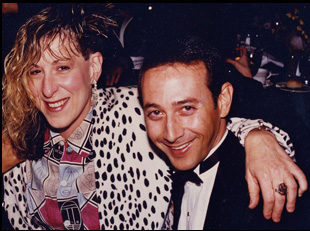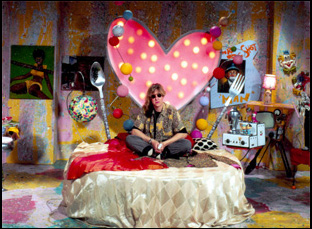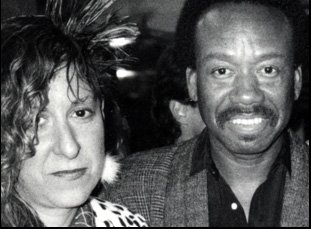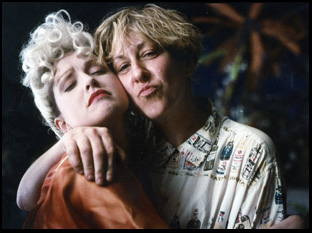It wasn’t entirely necessary to mention to friends of Allee Willis that they should put on something extra snazzy for their sit-down interviews in “The World According Allee Willis,” many of which were shot at the late artist’s home painted in pink with turquoise trim where flamingos and cactus intermingled on the lawn. But Alexis Spraic couldn’t leave things to chance.
“Our producer, Nick Cole did tell everyone to come wearing something that Allee would like as much as possible,” recalls Spraic, who got to see the rainbow every day she worked on the lively biography of the multitalented Willis, who parlayed a massively successful career as a songwriter into countless other artistic realms. “Tim Bagley, for instance, made a funny joke off-camera before we started shooting, saying ‘You know, I’m more of a Banana Republic guy,’ but he wore a pretty fun jacket in Allee’s honor, and he had a great line [later in the interview] where he said, ‘Allee just gave you permission to be a little extra.’”
It was only fair when Willis added a little something extra to everybody else’s life, though her name might not necessarily ring a bell with all those she’s touched. Between penning the lyrics for Earth, Wind and Fire’s “September” and The Rembrandts’ “I’ll Be There for You,” which became the theme song for “Friends,” Willis was never too far from hearing the reverberations of her work, but in a business where songwriters are usually far removed from the fame of those who perform their songs, especially the much more select group of women who can break into the industry in the first place, she wasn’t well-known. Even though collaborations with the likes of Cyndi Lauper and Patti LaBelle afforded her the ability to redevelop a former 1930s party home for MGM into Willis Wonderland, a fantastical home that few would want to leave — and often didn’t when her fabulous parties that brought out the likes of Paul Reubens and Mark Mothersbaugh didn’t end until the wee hours — Willis grew restless there, having had to put aside her own ambitions as a performer upon the poor reception of her debut album “Childstar” and her boundless creativity pushing her in any number of directions, from helping to bring “The Color Purple” to Broadway as a stage musical to developing an early social network called Willisville, whose CEO was a young Mark Cuban.
Fortunately for all, Willis recognized she lived a life of importance before her untimely passing in 2019 of a heart attack, insisting on filming herself or handing a camera off to friends as she went about an extraordinary existence and while it occasionally backfired — a decision to have one of her soirees broadcast live on ABC didn’t sit well with attendees who thought they would be partying in private — the footage gave Spraic a wealth of material to properly convey the magnitude of her contributions to the world. “The World According to Allee Willis” can feel overwhelming at times (in a good way) as it shows how Willis was overcome by the sounds of Motown herself as she grew up in Detroit, sitting outside the Hitsville USA studio as a kid, and sought to produce the same sensation of joy for others in all her creative endeavors. Joined later in life by her partner Prudence Fenton, no slouch in her own right as an animator who worked on Peter Gabriel’s groundbreaking videos for “Big Time” and “Steam” and an executive producer on MTV’s “Liquid Television,” Willis achieved building the kind of world she wanted to live in rather than the one she felt rejected from and it’s a cocoon that Spraic has generously invited everyone else into for her film’s runtime.
After premiering earlier this year at South By Southwest, “The World According to Allee Willis” is beginning its theatrical run this week and recently Spraic and Fenton spoke about honoring Willis’ final wishes in making a personal portrait that would ultimately reflect an entire community of artists and how she continues to inspire from the great beyond.

Alexis Spraic: He is the great connector of all things. He’s connected much more illustrious people than myself, but he was a friend of mine and he wanted me to talk to Prudence, kind of under false pretenses. She was looking for someone to make a documentary and fulfill Allee’s wish that someone put together this incredible archive that she’d left behind. Fortunately, we hit it off, and as I started to understand what the project was, I realized that Allee had really been a part of my whole life without my knowing it, just because of all the work that she’s created. That’s how we got started, and then we started to figure out what our approach was going to be and how to make it into a film.
Prudence Fenton: When I met Alexis, I had her over to the house and she showed up in a vintage jumpsuit with a vintage belt, and I went, “Oh, yes, I’ve got the right person.” She completely got the house and got the design, and, and we were in sync immediately.
The house appears to be a real base of operations in the film – you shoot interviews there and it’s constantly revealing itself. Did you know the role it could play in speaking to Allee’s life from the start?
Alexis Spraic: I don’t think you could have made the film without showing the house. It’s a huge part of Allee and when we talked to people, it felt like that was always what she wanted when she met you – if she was going to bring you into the fold, she’d want you to see the house first, and then it was like she could explain herself. She created this environment that brought you into her world, so we knew it was going to be a big character in the film.
It was really striking too if you’ve ever [lost a loved one] when you go to their home and you see their things, there’s usually a tinge of melancholy or sadness, and what’s amazing with what Allee built there is that it’s so happy. Just the colors and the curves and the freedom of thought that’s possible there. We wanted the look of the film to be very maximalist because that’s Allee, so our aesthetic was more is more and anytime we could get people there, it was our preferred place to shoot. And then every nook and cranny had something to discover, or sometimes some tangent or misdirection. Even now I go over there and see things I haven’t seen before, so it’s incredible what she created there.

Prudence Fenton: Allee had tried to make a documentary herself before, and what she wanted was a director who would be able to get inside her head and show that. She used ”The Devil and Daniel Johnston” as an example, and I told Alexis that it wasn’t necessarily on top of mind, but by the time we finished the documentary, you realized you were inside Allee’s world and knew what she thought, what she loved and what she hated. That was important to me to carry that through because she had felt so strongly about that and she really wanted somebody to know her through her creative process, how she thought, and how she created. And I think the film does do that.
Alexis Spraic: Speaking to Prudence was a wonderful touchstone, understanding that trying to do it with that in mind of being inside Allee’s head. And that certainly informed the title. If Allee had done the film, it would have been 20 hours. There were a lot of instructions, but it was hard enough for me as an outsider to make the choices I had to make between what we had and what to include and a guiding light really became trying to answer the question of why Allee wanted someone else to make the film, why she didn’t do it herself and left it to somebody. Because we interviewed her close friends, what I came to understand was how she was seen. She was just this extremely positive person. She knew how to bring the fun. She always seemed to find the joy or humor in moments, and then obviously she was so prolific and motivated and ambitious with her work.
The first time I went to the house, I asked Prudence, “What’s the conflict [here]?” Because of course, [you need one for] any story, and in that moment, we couldn’t really answer that question. Then going through the archives, there’s a line that Allee wrote in some of her instruction to whoever was going to direct the film where she is talking to herself saying, “I’ve always known I want my final art piece to be someone leaving the trail I’ve left behind,” [but also] “What if I lose my nerve and destroy everything before I die?” And I thought, God, this woman has all the nerve to lose. I realized there was a lot of vulnerability and fragility contained in the archives, a lot of struggle for self-acceptance, a lot of self-loathing, and a lot of normal human things that she hadn’t let many people in her life into or to see in her lifetime.
I think she really understood that that was part of the story and part of her life’s work of wanting to activate creativity in other people and inspire them to feel the freedom to be individuals was to show that it’s hard at times and that it was a struggle for her to accept herself. It wasn’t always easy, even if she made it look easy, so that ended up helping us in terms of filtering the archives, understanding we were going to show Allee’s journey to self-acceptance and how she managed to accomplish so much and persevere even when things weren’t working.

Prudence Fenton: Yeah, there were a couple of mysteries that came up. Certainly the “Childstar“ album and how that happened. She gave the impression that she only did a couple of concerts and Alexis found out she did a whole East Coast tour. She never was really that open with me about how upsetting that period of her life was for her. She’d just say, “I got tired of performing in a cafeteria and I stormed off.” And then there’s also times later on in the movie where when she went back to performing and she goes, “After 37 years, I’ve come back to performing for myself.” And that was a bit of a surprise to me because I didn’t realize it was something that she missed or really aspired to again. There were also relationships in the ‘80s that happened that were people she no longer spoke to, and I remember asking a lot of her friends, “Do you know what happened? And they’d go, “No, I have no idea,” and to this day, we think we know, but we never found the answer to that.
Alexis, was there anything that changed your ideas of what this was, or maybe took it in a direction you didn’t expect?
Alexis Spraic: Yeah, when you’re making a documentary, you’re drawing a map to a place you’ve never been, and you have to really be flexible and adaptable. As Prudence alluded to, “Childstar” was this album [Allee] wrote in 1974. It was very well-reviewed, but then her stage performance was really shocking to people because she came out in very masculine clothes and even though she’s recorded on the album singing in falsetto. It really defied expectations when she sang [on stage] in a deep voice. The things that people wrote in those reviews were so cruel and I know now we have online bullying, so it’s not foreign, but it’s pretty amazing that a few people probably going to those shows and writing things from a very close-minded point of view about gender and sexuality and self-expression inhibited so much of her life and I really wanted to do justice to that story.
It isn’t really a part of the film since it was set up only within the last couple years, but I was moved after to hear a bit more about the Willis Wonderland Foundation, which sounds like it was set up to help aspiring female artists combat all the things that Allie had to go through. Prudence, how did it come about?
Prudence Fenton: She wanted a legacy, and I feel like I did go against her on a certain level because I narrowed it down to the songwriting box. But I felt if people are going to give money to something, they want to know in one word or complete sentence what it is they’re promoting. She did art, she did furniture building, she was a curator, she did all these things, but she really was an amazing songwriter. And I never took a course in songwriting — it’s not offered in any school and yet it’s one of the things that brings people together and makes them happy and joyful. It creates community, so we’re putting songwriting courses for the public schools and colleges [with] Stephen Cox, a music educator that I hired, and it’s exploding. There’s such a demand for songwriting courses because you do music production with a purpose. You need to get out your song, you need to figure out what instruments you want to play and it’s a whole puzzle that you create that you then solve. And [the courses] are working
It’s founded on the talent that [Allee] truly had. And she had a specific process for writing songs, like if she was collaborating with someone and they got bored, she’d [say] “Let’s stop and go do something else. You [only] want to keep creating when the iron is hot. And if it’s not hot, don’t frustrate yourself and torture yourself to sit there and keep doing it.” She was very emphatic that it’s got to be joyful and the process has to be fun or you’re not going to get a good song. And I think that’s a great message to carry on and to have the world produce another 100,000 songwriters, that’s not a bad thing.

Alexis Spraic: I’ve just been really blown away by the audience response. We were just in Kansas at Tallgrass and we had a standing ovation at South by Southwest, and there’s nothing more fun than getting to show it to people.
Prudence Fenton: It makes me very happy that when you’re sitting in the audience and people gasp and laugh and cry in all the right places, and you think “Okay, I hit a note.” A lot of people have said, “My daughter’s coming out, and this has really helped me understand the struggles that they go through.” Or “my daughter or my son is trying to do something on his own and now he’s really inspired just to go out and do it no matter what.” It’s inspiring. And I know that’s what Allee wanted. She wanted to inspire people to their own creativity, because she believed that everybody had that creative germ no matter what, no matter what they were doing.
Alexis Spraic: And we told the story in a way that hopefully makes people feel uplifted and a little bit like they have some agency leaving the theater to live their lives a little differently or to express themselves a little bit more. That’s really satisfying, because we do depict the more dramatic and harder parts of her life, and I think someone from South By put a note on Letterboxd that’s one of my favorite things anyone said, which is “This movie makes me feel so alive.” That’s really fulfilling.
“The World According to Allee Willis” opens on November 15th in in New York at the Angelika Film Center and in Los Angeles at the Monica Film Center and will have a special one-night screening on November 19th at the Claremont 5, the Encino Town Center, the Laemmle Glendale and the NoHo 7.




